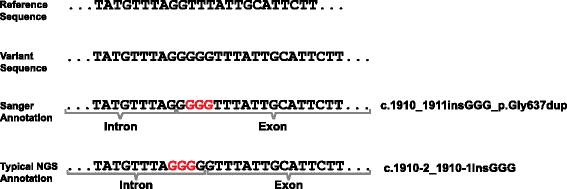CSN and CAVA: variant annotation tools for rapid, robust next-generation sequencing analysis in the clinical setting
- PMID: 26315209
- PMCID: PMC4551696
- DOI: 10.1186/s13073-015-0195-6
CSN and CAVA: variant annotation tools for rapid, robust next-generation sequencing analysis in the clinical setting
Abstract
Background: Next-generation sequencing (NGS) offers unprecedented opportunities to expand clinical genomics. It also presents challenges with respect to integration with data from other sequencing methods and historical data. Provision of consistent, clinically applicable variant annotation of NGS data has proved difficult, particularly of indels, an important variant class in clinical genomics. Annotation in relation to a reference genome sequence, the DNA strand of coding transcripts and potential alternative variant representations has not been well addressed. Here we present tools that address these challenges to provide rapid, standardized, clinically appropriate annotation of NGS data in line with existing clinical standards.
Methods: We developed a clinical sequencing nomenclature (CSN), a fixed variant annotation consistent with the principles of the Human Genome Variation Society (HGVS) guidelines, optimized for automated variant annotation of NGS data. To deliver high-throughput CSN annotation we created CAVA (Clinical Annotation of VAriants), a fast, lightweight tool designed for easy incorporation into NGS pipelines. CAVA allows transcript specification, appropriately accommodates the strand of a gene transcript and flags variants with alternative annotations to facilitate clinical interpretation and comparison with other datasets. We evaluated CAVA in exome data and a clinical BRCA1/BRCA2 gene testing pipeline.
Results: CAVA generated CSN calls for 10,313,034 variants in the ExAC database in 13.44 hours, and annotated the ICR1000 exome series in 6.5 hours. Evaluation of 731 different indels from a single individual revealed 92 % had alternative representations in left aligned and right aligned data. Annotation of left aligned data, as performed by many annotation tools, would thus give clinically discrepant annotation for the 339 (46 %) indels in genes transcribed from the forward DNA strand. By contrast, CAVA provides the correct clinical annotation for all indels. CAVA also flagged the 370 indels with alternative representations of a different functional class, which may profoundly influence clinical interpretation. CAVA annotation of 50 BRCA1/BRCA2 gene mutations from a clinical pipeline gave 100 % concordance with Sanger data; only 8/25 BRCA2 mutations were correctly clinically annotated by other tools.
Conclusions: CAVA is a freely available tool that provides rapid, robust, high-throughput clinical annotation of NGS data, using a standardized clinical sequencing nomenclature.
Figures

References
-
- dbSNP information for rs80357713. http://www.ncbi.nlm.nih.gov/SNP/.
-
- Wildeman M, van Ophuizen E, den dunnen JT, Taschner PE. Improving sequence variant descriptions in mutation databases and literature using the Mutalyzer sequence variation nomenclature checker. Hum. Mutat. 2008; 29, 6–13; Mutalyzer. http://mutalyzer.nl/. - PubMed
Publication types
MeSH terms
Substances
Grants and funding
LinkOut - more resources
Full Text Sources
Other Literature Sources
Miscellaneous

